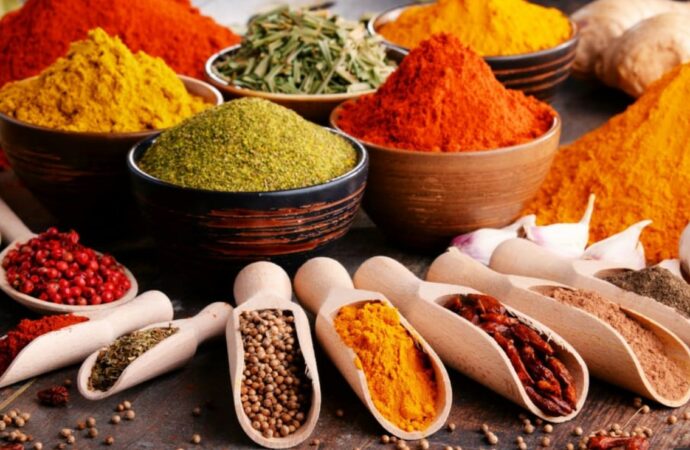There are several herbs and spices that have multiple potential health benefits, such as anti-inflammatory properties, cognitive boosters, and some that may even aid in cancer treatment, to name a few. Turmeric, peppermint, ginger, and other herbs and spices are among them. The ancient Greeks used a variety of spices and herbs for their healing
There are several herbs and spices that have multiple potential health benefits, such as anti-inflammatory properties, cognitive boosters, and some that may even aid in cancer treatment, to name a few. Turmeric, peppermint, ginger, and other herbs and spices are among them.

The ancient Greeks used a variety of spices and herbs for their healing properties long before modern medicine. Hippocrates (460-377 BCE) used saffron, cinnamon, thyme, coriander, and other plants as remedies, many of which are still used as holistic remedies for fevers, aches and pains, and other ailments today.
While there is little to no scientific evidence that herbs and spices directly cure serious diseases, research is showing that many herbs and spices have properties that may help mitigate certain symptoms.
This article will look at the health benefits of ten herbs and spices, including turmeric, peppermint, ginger, and others.
Turmeric

Turmeric, also known as curcumin, is one of the most popular spices used in cooking and for its health benefits. Turmeric has been shown in studies to have anti-inflammatory, antioxidant, antibacterial, antiviral, and antiparasitic properties. Turmeric is the most effective of these for its anti-inflammatory and antioxidant properties, according to research.
Turmeric, as a powerful antioxidant and anti-inflammatory spice, reduces oxidative stress by scavenging toxic free radicals in the body. Free radicals are tissue-damaging molecules with an uneven number of electrons that can act as catalysts in chronic diseases like cardiovascular disease and cancer.
Turmeric’s high antioxidant content can help to reduce the risk of free radical formation and the effects of stress on the body.
Ginger

Ginger has been used as a remedy for nausea and gastrointestinal issues for thousands of years. People nowadays primarily use ginger root as a spice or as a supplement to treat digestive issues.
Ginger, which is closely related to turmeric, has anti-inflammatory properties as well as a high level of total antioxidants. Only pomegranates and certain types of berries have a higher concentration. Several controlled studies have shown that ginger is effective as an antiemetic and antinausea agent. It can be used to treat seasickness, motion sickness, and morning sickness.
Ginger has been shown in some studies to have anti-cancer properties. This is due in large part to ginger’s high antioxidant levels. It can also cause cells to stop reproducing, stop dividing, and block certain activator proteins and signaling pathways that contribute to cancer. Having said that, the majority of these studies were conducted in a laboratory, and more human clinical trials are required.
Cumin

Cumin is a popular cooking spice that is used for its aromatic properties. According to research, it can also help with weight loss, cholesterol, stress management, and other things. It also has a high antioxidant capacity.
Cumin has also been shown in studies to be an anti-diabetic. Over a 24-week period, a group of 80 people took an Ayurvedic formulation containing cumin, and their postprandial blood sugar was significantly reduced.
Peppermint

Peppermint is a popular herb that is commonly used as a flavoring agent. It is native to Europe and Asia. Before modern medicine, people in these areas used it for its cooling effects, antibacterial properties, and to improve digestive health.
According to research, peppermint, as a holistic remedy, is also effective in improving cardiovascular (heart) and pulmonary (lung) health by acting as a bronchodilator. Bronchodilators work by widening the bronchioles (air passages) in the lungs. By inhaling the scent of peppermint, a person increases their nasal air force, allowing more air to enter the lungs.
Furthermore, some studies show that peppermint is an effective muscle relaxant due to its cooling menthol compound, which is why menthol is frequently used as an active ingredient in muscle pain ointments and creams.
Echinacea

Echinacea is a supplement derived from the coneflower plant that is best known for targeting the immune system and aiding in the prevention of colds. While research has yet to prove that the herb can fight viruses, many people use it to help treat conditions such as:
- the common cold
- upper respiratory infections
- bronchitis
- influenza
- inflammation
- ear infections
- vaginitis
- yeast infections
Treatments with echinacea for these illnesses have not been proven to be effective. The majority of studies indicate the opposite or are inconclusive at best. There may be a tenuous link between taking echinacea and immune system strengthening, but much of the evidence for the herb’s efficacy is anecdotal.
Cinnamon

Cinnamon has been used for anointing, embalming, and treating ailments since 2,800 BCE. Though it is no longer as widely used for its therapeutic properties as it once was, cinnamon still provides numerous health benefits as an antimicrobial, antioxidant, anti-inflammatory, antidiabetic, and anticarcinogenic spice.
According to a 2015 study, cinnamon may help lower blood sugar levels. Many small randomized control trials have suggested that it plays a role in glucose regulation in the body, but the results have not been significant enough to prove conclusive.
Cinnamon has also been shown to improve cognitive function, prompting researchers to investigate whether the spice could be used to treat Alzheimer’s disease. CEppt (an extract found in cinnamon bark) has been studied in particular to see if it can help prevent the progression of Alzheimer’s symptoms. When mice ate this extract, their cognitive ability improved significantly.
Chili powder

According to a 2015 study, capsaicin, the phytochemical that gives chili powder its spicy flavor, may play an important role in regulating heart and metabolic health.
When people eat chili powder, the spice causes beneficial protein changes in the body that aid in weight loss. However, researchers do not fully comprehend the mechanism by which this works. Participants in a 12-week study who consumed moderate amounts of chili experienced weight loss, which was triggered by chili’s impact on the body’s ability to better control insulin, among other therapeutic effects. In another study, researchers discovered that eating chili on a regular basis significantly reduced abdominal adipose tissue (fat) levels, as well as appetite and energy intake.
In terms of cardiovascular benefits, recent research from the American Heart Association discovered that those who consume chili powder on a regular basis may reduce their risk of developing heart disease mortality by 26%. Furthermore, frequent chili consumption is associated with a 25% reduction in overall mortality and a 23% reduction in cancer deaths.
Chili powder, because of its anti-inflammatory properties, may be useful in assisting arthritis treatments as well as relieving muscle and joint inflammation.
Parsley

The herb parsley is native to the Mediterranean region. Many people have used it for culinary flavoring as well as therapeutic treatment for a variety of health conditions, including high blood pressure and allergies, over the years.
This herb is high in antioxidants, carotenoids, and other vitamins that help maintain a healthy body and immune system. Vitamin K, an important nutrient for bone health, is one of them.
Oregano

Oregano is another herb that is common in the Mediterranean diet, and it is used not only as a flavor enhancer for food but also as an aromatic oil and supplement. The antioxidants in the herb contribute to its strong flavor and aroma, and they may also provide benefits such as:
- strengthening the immune system against infections
- reducing inflammation
- regulating blood sugar
- improving insulin resistance
- alleviating urinary tract symptoms and menstrual cramps
- fighting cancer
Oregano, as a stand-alone herb, cannot achieve these results. However, it may be used for its antioxidative properties, which are beneficial for a variety of health conditions.
Cardamom

Cardamom is yet another spice with numerous potential health benefits. Cardamom, which is derived from the seeds of plants in the ginger family, is commonly used in teas such as chai tea, as well as coffee, desserts, and even savory dishes.
Cardamom has been shown in studies to treat the following conditions:
- constipation
- colic
- diarrhea
- dyspepsia
- vomiting
- headache
- epilepsy
- cardiovascular disease.
The healing properties of the spice are primarily due to a combination of its volatile oils, fixed oils, phenolic acids, and sterols. Cardamom seeds, in particular, contain volatile oils that are analgesic, anti-inflammatory, antimicrobial, and antispasmodic.
Cardamom may also help with obesity and high cholesterol, according to animal studies. Cardamom supplementation reduced total cholesterol and triglyceride levels in obese rats, according to research.
Summary
Herbs and spices not only add flavor to meals, but they are also high in essential nutrients that benefit the body greatly.
People who incorporate herbs and spices into their diet may experience some benefits or health improvements, but they should not rely on them solely for a full treatment of conditions. Those who have serious medical conditions should consult with a doctor to determine the best course of treatment for them.
 Magazine
Magazine 


















Leave a Comment
Your email address will not be published. Required fields are marked with *